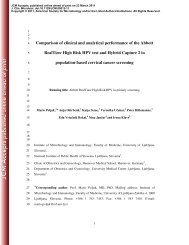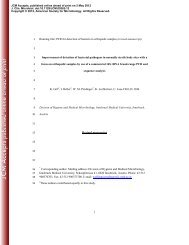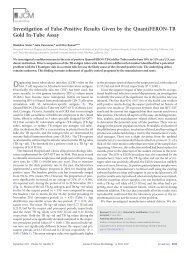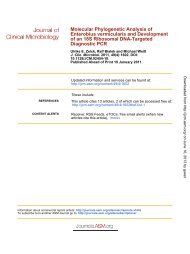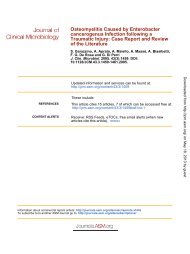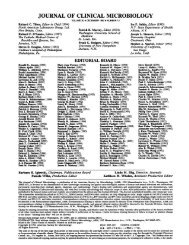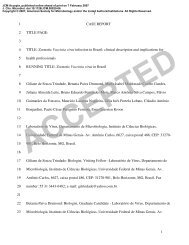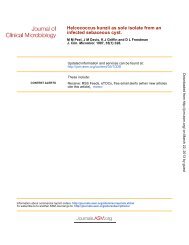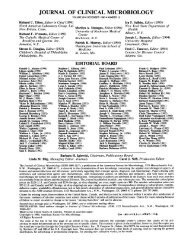Enterobius vermicularis in a 14 year-old girl's eye - Journal of ...
Enterobius vermicularis in a 14 year-old girl's eye - Journal of ...
Enterobius vermicularis in a 14 year-old girl's eye - Journal of ...
You also want an ePaper? Increase the reach of your titles
YUMPU automatically turns print PDFs into web optimized ePapers that Google loves.
JCM Accepts, published onl<strong>in</strong>e ahead <strong>of</strong> pr<strong>in</strong>t on 28 September 2011<br />
J. Cl<strong>in</strong>. Microbiol. doi:10.1128/JCM.05475-11<br />
Copyright © 2011, American Society for Microbiology and/or the Listed Authors/Institutions. All Rights Reserved.<br />
1<br />
2<br />
3<br />
4<br />
5<br />
6<br />
7<br />
8<br />
9<br />
10<br />
11<br />
12<br />
13<br />
<strong>14</strong><br />
15<br />
16<br />
17<br />
18<br />
19<br />
20<br />
21<br />
22<br />
23<br />
<strong>Enterobius</strong> <strong>vermicularis</strong> <strong>in</strong> a <strong>14</strong> <strong>year</strong>-<strong>old</strong> girl’s <strong>eye</strong><br />
N. Esther Babady 1† , Erich Awender 2 , Robert Geller 2 , Terry Miller 2 , Gayle Scheetz 2 , Heather<br />
Arguello 1 , Scott A. Weisenberg 4 and Bobbi Pritt 1*<br />
1 Mayo Cl<strong>in</strong>ic, Rochester, MN; 2 Freeport Health Network, Freeport; IL; 3 Alta Bates Summit<br />
*Correspond<strong>in</strong>g Author.<br />
Mail<strong>in</strong>g Address:<br />
Mayo Cl<strong>in</strong>ic<br />
200 1 st Street SW<br />
Medical Center, Oakland, CA<br />
Division <strong>of</strong> Cl<strong>in</strong>ical Microbiology, Hilton Build<strong>in</strong>g, 4 th Floor<br />
Rochester, M<strong>in</strong>nesota 55905<br />
Phone: (507) 538-8182<br />
Fax: (507) 266-4341<br />
E-mail: pritt.bobbi@mayo.edu<br />
† Present address: Memorial Sloan-Ketter<strong>in</strong>g Cancer Center, New York, NY<br />
1
24<br />
25<br />
26<br />
27<br />
28<br />
29<br />
30<br />
31<br />
32<br />
33<br />
34<br />
35<br />
36<br />
37<br />
38<br />
39<br />
40<br />
41<br />
42<br />
43<br />
44<br />
45<br />
46<br />
47<br />
48<br />
49<br />
50<br />
51<br />
52<br />
53<br />
54<br />
55<br />
56<br />
57<br />
58<br />
59<br />
60<br />
61<br />
62<br />
63<br />
64<br />
ABSTRACT<br />
We report an unusual case <strong>of</strong> extra<strong>in</strong>test<strong>in</strong>al <strong>in</strong>fection with adult <strong>Enterobius</strong> <strong>vermicularis</strong><br />
worms <strong>in</strong> the nares and ocular orbit <strong>of</strong> a <strong>14</strong> <strong>year</strong>-<strong>old</strong> girl <strong>in</strong> Ill<strong>in</strong>ois, USA. Only one other similar<br />
case has been reported <strong>in</strong> the English literature.<br />
2
65<br />
66<br />
67<br />
68<br />
69<br />
70<br />
71<br />
72<br />
73<br />
74<br />
75<br />
76<br />
77<br />
78<br />
79<br />
80<br />
81<br />
82<br />
83<br />
84<br />
85<br />
86<br />
87<br />
88<br />
CASE REPORT<br />
A <strong>14</strong> <strong>year</strong>-<strong>old</strong> Caucasian girl presented to the local emergency department (ED) after<br />
hav<strong>in</strong>g removed and discarded what she described as a small motile worm from her <strong>eye</strong> the night<br />
before. On physical exam<strong>in</strong>ation, she appeared well and her vision was normal. Ocular exam by<br />
a nurse revealed a s<strong>in</strong>gle motile worm beneath the right lower lid <strong>in</strong> the <strong>in</strong>ferior conjunctival sac<br />
which was removed on a cotton swab. The patient was also seen by a Physician’s Assistant (PA)<br />
who identified and removed 3 additional worms over a 60 m<strong>in</strong>ute period. The patient was then<br />
seen by an ED physician, and Ophthalmology and <strong>in</strong>fectious diseases specialists were consulted.<br />
Based on the evaluation, the patient was discharged home with Cipr<strong>of</strong>loxac<strong>in</strong> ophthalmic<br />
solution (1-2 drops to each <strong>eye</strong> applied twice per day) and <strong>in</strong>structed to follow up with the on-<br />
call ophthalmologist <strong>in</strong> 2 days. However, the patient returned to the ED with<strong>in</strong> 1 hour <strong>of</strong><br />
discharge and two additional worms were identified and removed from the anterior surface <strong>of</strong> the<br />
right <strong>eye</strong> and <strong>in</strong>ferior conjunctival sac. Further exam<strong>in</strong>ation <strong>of</strong> the superior conjunctival sacs<br />
(with lid eversion), the medial canthus, the medial punctum and the nares bilaterally did not<br />
reveal the presence <strong>of</strong> other worms. No additional treatment or follow-up was recommended at<br />
this time and the patient was aga<strong>in</strong> discharged home. The follow<strong>in</strong>g day, the patient reported a<br />
worm crawl<strong>in</strong>g out <strong>of</strong> her nose, which she discarded. She denied any additional symptoms such<br />
as nocturnal perianal pruritus or worms <strong>in</strong> her stool and denied any travel outside <strong>of</strong> the United<br />
States or known exposure to <strong>in</strong>dividuals with helm<strong>in</strong>th <strong>in</strong>fections. A peri-anal cellulose tape<br />
preparation was not obta<strong>in</strong>ed but a stool parasite exam<strong>in</strong>ation obta<strong>in</strong>ed 2 days after her ED visit<br />
by her primary care physician revealed ova <strong>of</strong> <strong>Enterobius</strong> <strong>vermicularis</strong>. Based on this result, she<br />
was treated with a 3 day course <strong>of</strong> mebendazole (300 mg twice daily), but reported mucous nasal<br />
and ocular discharge. Therefore, a computed tomography scan <strong>of</strong> her s<strong>in</strong>uses and an orbital MRI<br />
3
89<br />
90<br />
91<br />
92<br />
93<br />
94<br />
95<br />
96<br />
97<br />
98<br />
99<br />
100<br />
101<br />
102<br />
103<br />
104<br />
105<br />
106<br />
107<br />
108<br />
109<br />
110<br />
111<br />
were performed 12 days after her visit to the ED and were <strong>in</strong>terpreted as normal. On the advice<br />
<strong>of</strong> an <strong>in</strong>fectious diseases specialist, the primary care physician prescribed a repeat course <strong>of</strong> oral<br />
mebendazole (300 mg twice daily for 3 days), followed by complete resolution <strong>of</strong> her symptoms.<br />
Six worms isolated from the patient’s <strong>eye</strong> on both visits to the ED were collected <strong>in</strong><br />
sal<strong>in</strong>e and submitted for identification to the Parasitology Laboratory at the Mayo Cl<strong>in</strong>ic <strong>in</strong><br />
Rochester, MN. On macroscopic exam<strong>in</strong>ation, the worms were white-tan and ranged <strong>in</strong> length<br />
from 4-10 mm. Microscopic exam<strong>in</strong>ation <strong>of</strong> a representative worm revealed structures<br />
consistent with an adult female <strong>Enterobius</strong> <strong>vermicularis</strong>, <strong>in</strong>clud<strong>in</strong>g lateral alae, bulbous and<br />
muscular esophagus, gravid uterus conta<strong>in</strong><strong>in</strong>g characteristic eggs and po<strong>in</strong>ted tail (Figure 1).<br />
---------------------------------------------------------------------------------------------------------------------<br />
DISCUSSION<br />
E. <strong>vermicularis</strong>, <strong>of</strong>ten referred to as p<strong>in</strong>worm, is an <strong>in</strong>test<strong>in</strong>al nematode which commonly<br />
<strong>in</strong>fects children throughout the world. Transmission <strong>of</strong> E. <strong>vermicularis</strong> eggs occurs through the<br />
fecal-oral route, with eggs be<strong>in</strong>g directly <strong>in</strong>oculated from the f<strong>in</strong>gers <strong>in</strong>to the mouth. Fomites<br />
may also play a role <strong>in</strong> transmission. The eggs are <strong>in</strong>fective shortly after be<strong>in</strong>g laid, mak<strong>in</strong>g<br />
auto<strong>in</strong>fection a common route <strong>of</strong> <strong>in</strong>test<strong>in</strong>al <strong>in</strong>fection. Follow<strong>in</strong>g <strong>in</strong>gestion, the embryonated eggs<br />
hatch <strong>in</strong> the small <strong>in</strong>test<strong>in</strong>e and develop <strong>in</strong>to adult worms that reside <strong>in</strong> the cecum, appendix,<br />
colon and rectum. Male and female worms mate <strong>in</strong> the human <strong>in</strong>test<strong>in</strong>al tract, and the gravid<br />
female worm migrates to the anus to lay partially embryonated eggs on the perianal and per<strong>in</strong>eal<br />
surfaces. The migration <strong>of</strong> the female worm to the anus causes pruritus, which is the most<br />
common symptom <strong>of</strong> p<strong>in</strong>worm <strong>in</strong>fection (7, 11). Less commonly, the presence <strong>of</strong> adult worms<br />
<strong>in</strong> the appendix can lead to obstruction, <strong>in</strong>flammation, and resultant appendicitis (6, 9). Rarely,<br />
the adult worms can become lodged <strong>in</strong> the <strong>in</strong>test<strong>in</strong>al mucosa and cause <strong>in</strong>test<strong>in</strong>al abscess.<br />
4
112<br />
113<br />
1<strong>14</strong><br />
115<br />
116<br />
117<br />
118<br />
119<br />
120<br />
121<br />
122<br />
123<br />
124<br />
125<br />
126<br />
127<br />
128<br />
129<br />
130<br />
131<br />
132<br />
133<br />
134<br />
Extra<strong>in</strong>test<strong>in</strong>al presentation is also very rare. The most common extra<strong>in</strong>test<strong>in</strong>al site is the<br />
female reproductive tract (vag<strong>in</strong>a, uterus, ovaries and fallopian tubes) due to migration <strong>of</strong> the<br />
female worm from the anus (4, 13-<strong>14</strong>). The female worm can also enter the ur<strong>in</strong>ary tract (15) and<br />
kidney (3), and biliary tract and liver(10). F<strong>in</strong>ally, there are isolated case reports <strong>of</strong> <strong>in</strong>fection<br />
<strong>in</strong>volv<strong>in</strong>g the salivary glands (8) nasal mucosa (12), sk<strong>in</strong> (1) and lungs (2), presumably due to<br />
auto<strong>in</strong>oculation <strong>of</strong> these sites with eggs or adult worms from the <strong>in</strong>test<strong>in</strong>al tract.<br />
A review <strong>of</strong> the English literature revealed only one other case <strong>of</strong> E. <strong>vermicularis</strong><br />
<strong>in</strong>fection <strong>in</strong> the <strong>eye</strong> (5). This case from 1976 shows a remarkable similarity to the current case, as<br />
it describes an <strong>in</strong>fection <strong>of</strong> a 15 <strong>year</strong>-<strong>old</strong> girl with a 7 day history <strong>of</strong> worms “crawl<strong>in</strong>g out <strong>of</strong> her<br />
<strong>eye</strong>s.” Her vision was normal and she cont<strong>in</strong>ued to expel worms for approximately three weeks,<br />
with a total number <strong>of</strong> 42 worms identified. This patient did not have any other compla<strong>in</strong>ts and<br />
stool exams were negative for worms. One difference between this case and ours is the fact that<br />
the patient never reported worms emerg<strong>in</strong>g from her nose. There was no <strong>in</strong>dication <strong>in</strong> the<br />
previous report that a cellulose tape test was done.<br />
Accord<strong>in</strong>g to the CDC guidel<strong>in</strong>es (16), the recommended treatment for p<strong>in</strong>worm<br />
<strong>in</strong>fection is oral pyrantel pamoate, given at a dose <strong>of</strong> 11 mg/kg. Alternatively, patients may be<br />
given one dose <strong>of</strong> Mebendazole (100 mg tablet). A second dose may be given <strong>in</strong> cases where the<br />
<strong>in</strong>fection persists—typically the result <strong>of</strong> auto<strong>in</strong>oculation. Test<strong>in</strong>g and/or treatment should also<br />
be considered for househ<strong>old</strong> contacts, s<strong>in</strong>ce environmental contam<strong>in</strong>ation with <strong>in</strong>fective eggs is<br />
common. In this case, other members <strong>of</strong> the househ<strong>old</strong> were not tested or treated for p<strong>in</strong>worm<br />
<strong>in</strong>fection, but recommendations for environmental clean<strong>in</strong>g were given.<br />
Treatment <strong>of</strong> extra<strong>in</strong>test<strong>in</strong>al <strong>in</strong>fections is not standardized. In the 1976 report by Dutta et<br />
al.(5), the patient was treated with a wash solution made <strong>of</strong> oral piperaz<strong>in</strong>e citrate diluted <strong>in</strong><br />
5
135<br />
136<br />
137<br />
138<br />
139<br />
<strong>14</strong>0<br />
<strong>14</strong>1<br />
<strong>14</strong>2<br />
<strong>14</strong>3<br />
<strong>14</strong>4<br />
<strong>14</strong>5<br />
<strong>14</strong>6<br />
<strong>14</strong>7<br />
<strong>14</strong>8<br />
<strong>14</strong>9<br />
150<br />
151<br />
152<br />
153<br />
154<br />
155<br />
156<br />
157<br />
water. In cases where the worms becomes lodged <strong>in</strong> tissue such as the appendix or ovaries (4, 6),<br />
surgery is performed to remove the worm, followed by treatment with mebendazole. In our case,<br />
the patient was treated with an extended course <strong>of</strong> weekly mebendazole, followed by resolution<br />
<strong>of</strong> her symptoms. The presumed failure <strong>of</strong> the <strong>in</strong>itial three day treatment may be due to relative<br />
<strong>in</strong>effectiveness <strong>of</strong> mebendazole towards worms <strong>in</strong> earlier stages <strong>of</strong> development (17) or may be<br />
due to a relatively protected non-<strong>in</strong>test<strong>in</strong>al worm location.<br />
In conclusion, we report here an extremely rare case <strong>of</strong> E. <strong>vermicularis</strong> detection <strong>in</strong> a<br />
young girl’s <strong>eye</strong> and possibly, nose. Although the mechanism by which eggs or worms reached<br />
this location is not clear, it is most likely the result <strong>of</strong> direct <strong>in</strong>oculation <strong>of</strong> adult female worms<br />
from the perianal sk<strong>in</strong> to the <strong>eye</strong>s by the child’s f<strong>in</strong>gers. Alternatively, eggs could have been<br />
<strong>in</strong>advertently <strong>in</strong>oculated, followed by hatch<strong>in</strong>g <strong>of</strong> both male and female worms and fertilization<br />
<strong>of</strong> some <strong>of</strong> the female worms. S<strong>in</strong>ce not all <strong>of</strong> the worms that were found <strong>in</strong> the child’s nose and<br />
<strong>eye</strong> were submitted for evaluation, we do not know if there were any male worms present<br />
(though they would be less likely to migrate). Only gravid females were identified <strong>in</strong> the<br />
laboratory. Both scenarios assume the presence <strong>of</strong> a primary <strong>in</strong>test<strong>in</strong>al <strong>in</strong>fection, which was<br />
diagnosed by f<strong>in</strong>d<strong>in</strong>g characteristic eggs <strong>in</strong> the stool <strong>of</strong> this patient.<br />
Figure 1 legend<br />
Gravid female (left) demonstrat<strong>in</strong>g lateral alae (arrow heads, unsta<strong>in</strong>ed worm, 40 times orig<strong>in</strong>al<br />
magnification). Higher magnification <strong>of</strong> the worm (right) reveals characteristic eggs <strong>of</strong><br />
<strong>Enterobius</strong> <strong>vermicularis</strong> (unsta<strong>in</strong>ed, 400 times orig<strong>in</strong>al magnification)<br />
6
158<br />
159<br />
160<br />
161<br />
162<br />
163<br />
164<br />
165<br />
166<br />
167<br />
168<br />
169<br />
170<br />
171<br />
172<br />
173<br />
174<br />
175<br />
176<br />
177<br />
178<br />
REFERENCES<br />
1. Arora, V. K., N. S<strong>in</strong>gh, S. Chaturvedi, and A. Bhatia. 1997. F<strong>in</strong>e needle aspiration<br />
diagnosis <strong>of</strong> a subcutaneous abscess from <strong>Enterobius</strong> <strong>vermicularis</strong> <strong>in</strong>festation. A case<br />
report. Acta Cytol 41:1845-7.<br />
2. Beaver, P. C., J. J. Kriz, and T. J. Lau. 1973. Pulmonary nodule caused by <strong>Enterobius</strong><br />
<strong>vermicularis</strong>. Am J Trop Med Hyg 22:711-3.<br />
3. Cateau, E., M. Yacoub, C. Tavilien, B. Becq-Giraudon, and M. H. Rodier. 2010.<br />
<strong>Enterobius</strong> <strong>vermicularis</strong> <strong>in</strong> kidney : an unusual location. J Med Microbiol.<br />
4. Craggs, B., E. De Waele, K. De Vogelaere, I. Wybo, M. Laubach, A. Hoorens, and B.<br />
De Waele. 2009. <strong>Enterobius</strong> <strong>vermicularis</strong> <strong>in</strong>fection with tuboovarian abscess and<br />
peritonitis occurr<strong>in</strong>g dur<strong>in</strong>g pregnancy. Surg Infect (Larchmt) 10:545-7.<br />
5. Dutta, L. P., and S. N. Kalita. 1976. <strong>Enterobius</strong> <strong>vermicularis</strong> <strong>in</strong> the human conjunctival<br />
sac. Indian J Ophthalmol 24:34-5.<br />
6. Efraimidou, E., A. Gatopoulou, C. Stamos, N. Lirantzopoulos, and G. Kouklakis.<br />
2008. <strong>Enterobius</strong> Vermicularis <strong>in</strong>fection <strong>of</strong> the appendix as a cause <strong>of</strong> acute appendicitis<br />
<strong>in</strong> a Greek adolescent: a case report. Cases J 1:376.<br />
7. Garcia, L. 2007. <strong>Enterobius</strong> <strong>vermicularis</strong>, p. 258-261. In L. S. Garcia (ed.), Diagnostic<br />
Medical Parasitology. ASM Press, Wash<strong>in</strong>gton, DC.<br />
8. Gargano, R., R. Di Legami, E. Maresi, and S. Restivo. 2003. Chronic sialoadenitis<br />
caused by <strong>Enterobius</strong> <strong>vermicularis</strong>: case report. Acta Otorh<strong>in</strong>olaryngol Ital 23:319-21.<br />
7
179<br />
180<br />
181<br />
182<br />
183<br />
184<br />
185<br />
186<br />
187<br />
188<br />
189<br />
190<br />
191<br />
192<br />
193<br />
194<br />
195<br />
196<br />
197<br />
198<br />
199<br />
200<br />
9. Isik, B., M. Yilmaz, N. Karadag, L. Kahraman, G. Sogutlu, S. Yilmaz, and V.<br />
Kirimlioglu. 2007. Appendiceal <strong>Enterobius</strong> <strong>vermicularis</strong> <strong>in</strong>festation <strong>in</strong> adults. Int Surg<br />
92:221-5.<br />
10. Little, M. D., C. J. Cuello, and A. D'Alessandro. 1973. Granuloma <strong>of</strong> the liver due to<br />
<strong>Enterobius</strong> <strong>vermicularis</strong>. Report <strong>of</strong> a case. Am J Trop Med Hyg 22:567-9.<br />
11. Orihel, A. L. a. T. 2007. <strong>Enterobius</strong> <strong>vermicularis</strong>, p. 191-195. In A. L. a. T. Orihel (ed.),<br />
Atlas <strong>of</strong> Human Parasitology. ASCP Press, S<strong>in</strong>gapore.<br />
12. Vasudevan, B., B. B. Rao, K. N. Das, and Anitha. 2003. Infestation <strong>of</strong> <strong>Enterobius</strong><br />
<strong>vermicularis</strong> <strong>in</strong> the nasal mucosa <strong>of</strong> a 12 yr <strong>old</strong> boy--a case report. J Commun Dis<br />
35:138-9.<br />
13. Worley, M. J., Jr., B. M. Slomovitz, E. C. Pirog, T. A. Caputo, and W. J. Ledger.<br />
2009. <strong>Enterobius</strong> <strong>vermicularis</strong> <strong>in</strong>festation <strong>of</strong> a hysterectomy specimen <strong>in</strong> a patient with a<br />
colonic reservoir. Am J Obstet Gynecol 200:e6-7.<br />
<strong>14</strong>. Young, C., I. Tataryn, K. T. Kowalewska-Grochowska, and B. Balachandra. 2010.<br />
<strong>Enterobius</strong> <strong>vermicularis</strong> <strong>in</strong>fection <strong>of</strong> the fallopian tube <strong>in</strong> an <strong>in</strong>fertile female. Pathol Res<br />
Pract.<br />
15. Zahariou, A., M. Karamouti, and P. Papaioannou. 2007. <strong>Enterobius</strong> <strong>vermicularis</strong> <strong>in</strong><br />
the male ur<strong>in</strong>ary tract: a case report. J Med Case Reports 1:137.<br />
16. The Medical Letter On Drugs and Therapeutics. Drugs For Parasitic Infections. 2010. The<br />
Medical Letter, Inc., New Rochelle, NY.<br />
17. Cho SY, Kang SY, Kim SI, Song CY. 1985. Effect <strong>of</strong> anthelm<strong>in</strong>tics on the early stage<br />
<strong>of</strong> <strong>Enterobius</strong> <strong>vermicularis</strong>. Kisaengchunghak Chapchi. 1985 Jun;23(1):7-17.<br />
8
201<br />
202<br />
9





